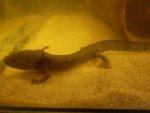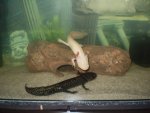Hi S and S,
Shriveled gills, stress, and inappetitance are usually an indication of water quality issues, or tank environment issues.
There may be several contributing factors, such as:
Water movement
You mentioned you have two filters at work in your 70 litre tank. Water currents will stress an axolotl and this stress can kill them. Do you have anything in place to obstruct the flow or diffuse the current issued by the outtakes of these filters? For a 70 litre one filter is ample to provide aeration to the tank.
To prevent water movement stress you can either afix a spray bar to the filter's outtake to diffuse the flow (with a little ingenuity you can make this yourself as it is just a perferated tube), you may place an obstruction in front of the outtake to break the current, or some filters have an adjustable outtake which will allow you to redirect the flow to the tank wall so the current does not disturb the axolotls.
Water quality
If the Ammonia or Nitrite levels are higher than '0' this is toxic to the axolotl. If there is no reading for Nitrate then this would indicate the cycle has not yet completed or has completely crashed. A complete cycle's readings should be Ammonia and Nitrite at a consistant '0' and the Nitrate should be 10-60.
In a fully cycled tank the Ammonia and Nitrite is broken down and converted to Nitrate rendering them non toxic. Nitrate 10-60 is not dangerous, if the Nitrate climbs above 60 however then this is dangerous and then partial water changes will need to be done to bring it down to acceptable levels.
What sort of test kit are you using? If you are using dipstrips these are notorious for giving inaccurate readings. The most reliable test kits are the test tube kits. If you are using test tube kits are they within their expiry date?
Bloodworm while a good food nutritionally is also as you have discovered very messy. Uneaten bloodworm will get everywhere, including sifting under the substrate where it will rot and wreak havoc with water quality, bloodworm can also contribute to water cloudiness.
Water Temperature
The optimum temperature range for an axolotl is 14-18 degrees celcius. The axolotl will tolerate temperature up to 23C, but if the temperature is over 24C then the axolotl will likely get ill due to heat stress which can quickly lead to death.
Impaction
Impaction is caused by the axolotl consuming gravel which they can't pass. You mentioned you have gravel in the tank. Any gravel smaller than 2cm in length presents a danger to axolotls. Impaction occurs when the ingested gravel blocks the gut, this can lead to death.
If you suspect your axolotl has swallowed stones, fridging will help the axolotl to relax and pass the stones.
Hides and Light
Axolotls have no eyelids and don't care much for light as they are nocturnal. Are there sufficient hides in the tank so the axolotl can get away from the light during the day if it is disturbing him? Hides make axolotls feel secure, if the axolotls are constantly out in the open with nowhere to hide away this can stress them.
For now....
For now, I would move the axolotl out of the tank and place him in a tub of fresh dechlorinated water until the problem can be ascertained and corrected. The axolotl needs to be kept in a stress free, cool, still, dark environment which will hopefully encourage him to eat as he is far too thin.
If there is nowhere cool to keep the axolotl, you may need to consider fridging him. Fridging will slow the metabolism to the point where the axolotl will not be inclined to eat, but the weight loss will also slow down which is an advantage and will help buy time to find and deal with issues in the tank environment.
While living in this temporary accommodation the axolotl will need his water changed 100% each day with fresh dechlorinated water.
Fridging Procedure:
- Prepare a tub of fresh dechlorinated water (select tub that is long enough for the axie to stretch out to his full length).
- Put enough water to cover the axolotl's back, ensure he can touch the ground but cannot float.
- Set fridge for 5-8 degrees celcius, no lower than 5 degrees.
- Keep jugs/bottles of fresh dechlorinated water in the fridge
- The axolotl will need his water changed 100% daily with the fridged dechlorinated water.
Eva has linked an excellent article on acceptable foods for an axolotl. The most nutritious food is earthworm, but if the axolotl will not eat earthworm I would offer liver, beef heart anything to get some food into that axie, something is better than nothing at this point.
The articles section Eva (aka Blueberlin) also provides a wealth of information on Water quality (most important), cycling, ideal filters for axolotls, cooling an aquarium (invaluable information for Australians with axolotls), appropriate foods (earthworm is best), and much much more.
In a nutshell:
- Is there any water current in the tank?
- What are the exact water parameters for Ammonia (toxic), Nitrite (toxic) and Nitrate (non toxic below 60)? Mixed up readings in Nitrite and Nitrate can be disasterous, please retest all parameters and advise.
- What is the tank water temperature?
- What size is the gravel in the tank?
- Are there any hides in the tank?
- Are there any other tank mates in the tank such as fish?



